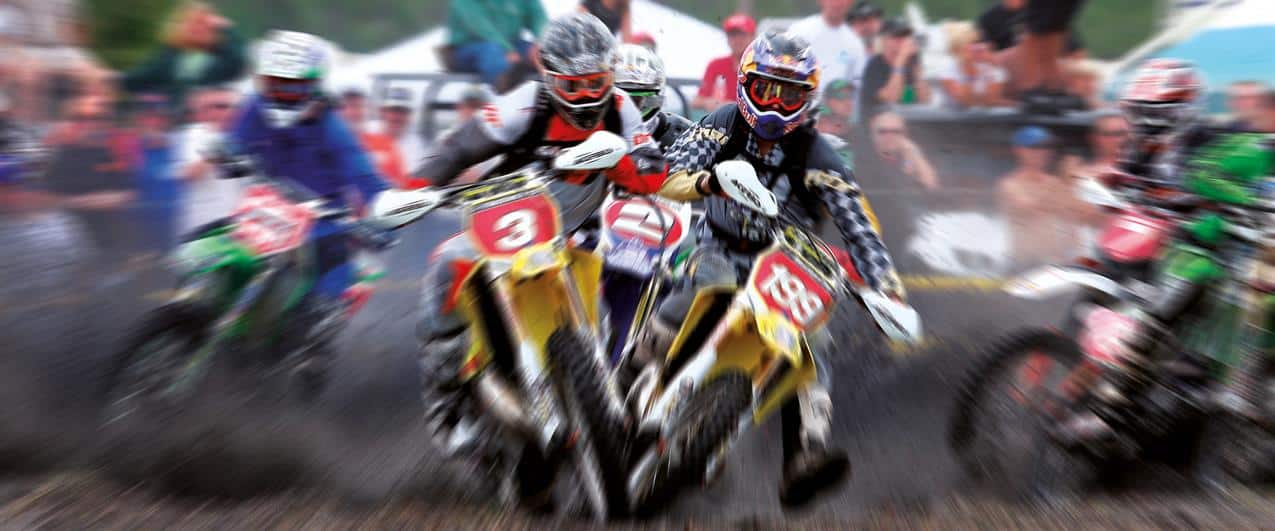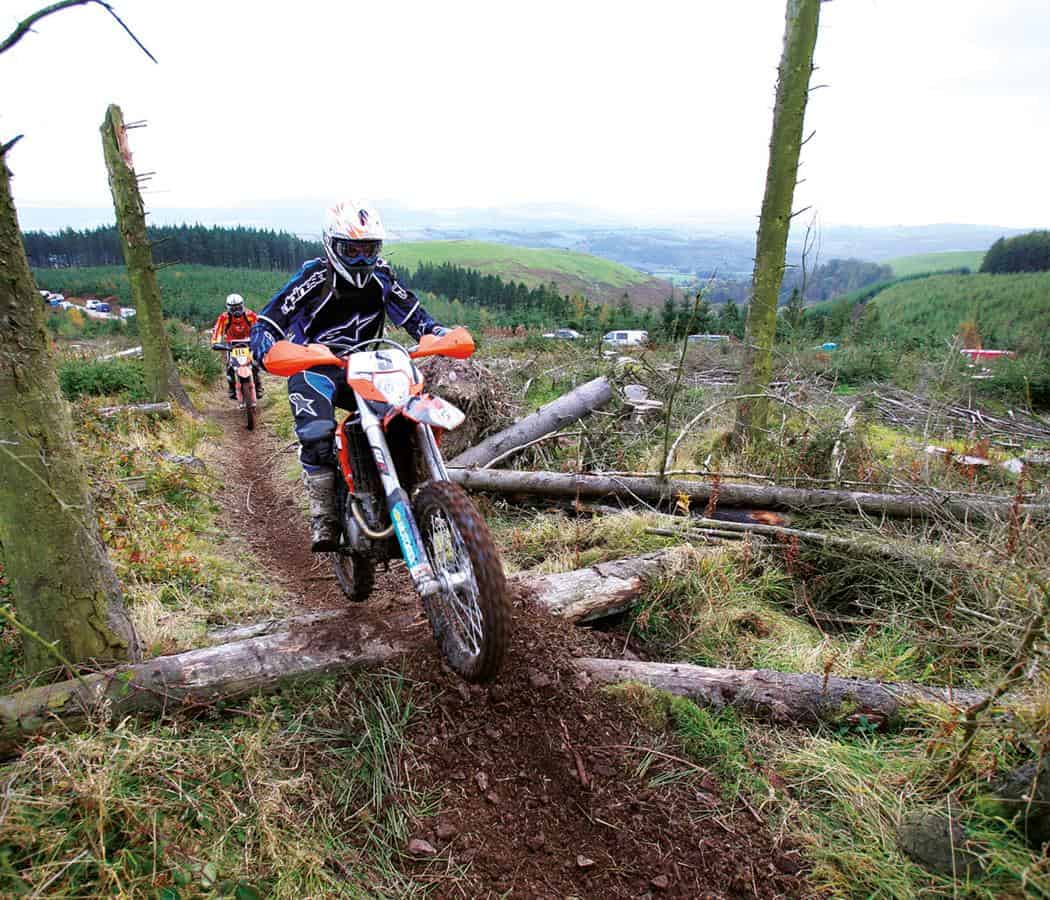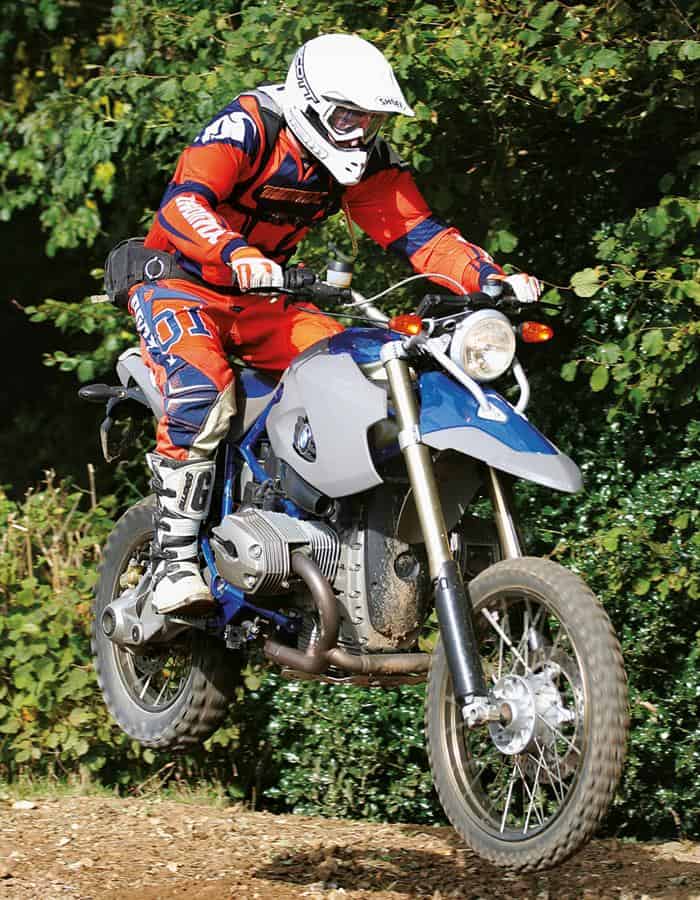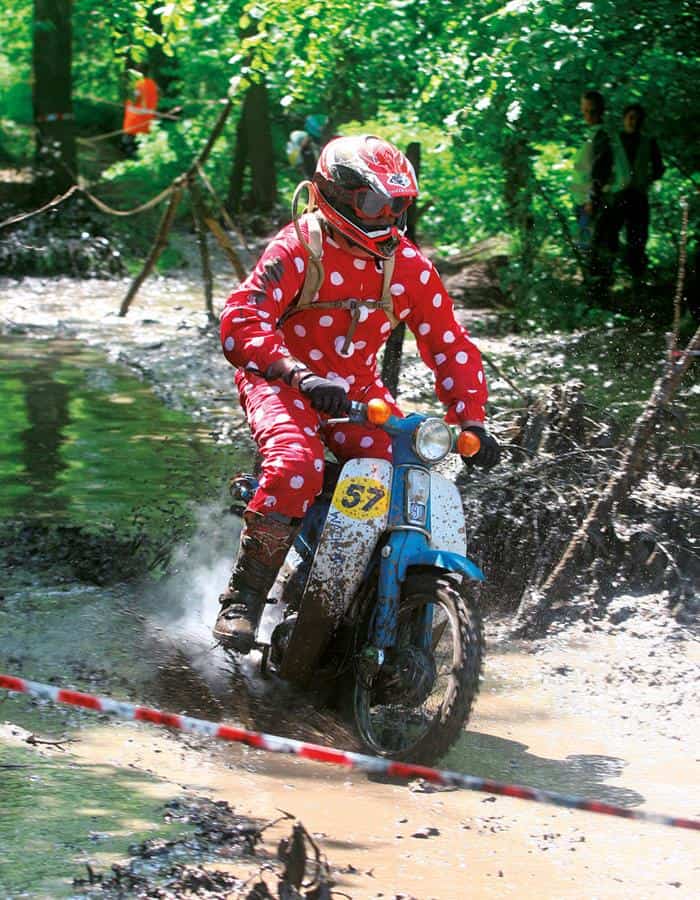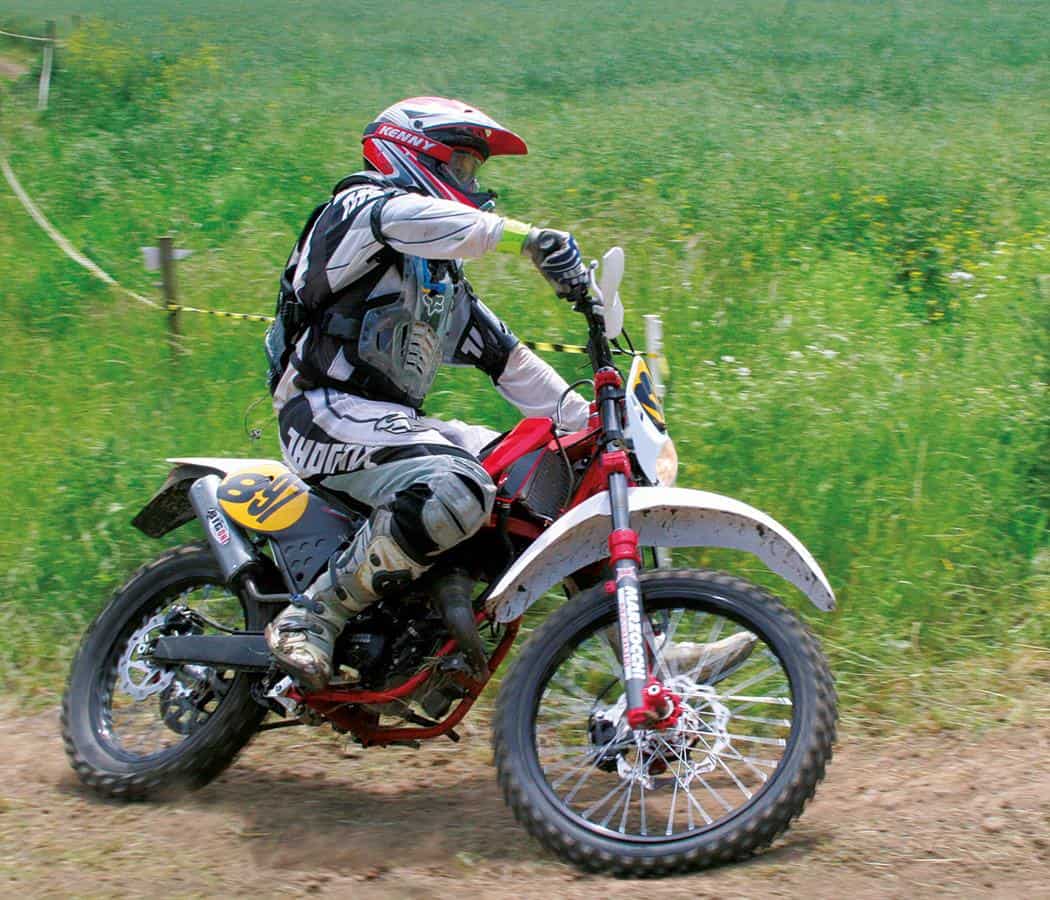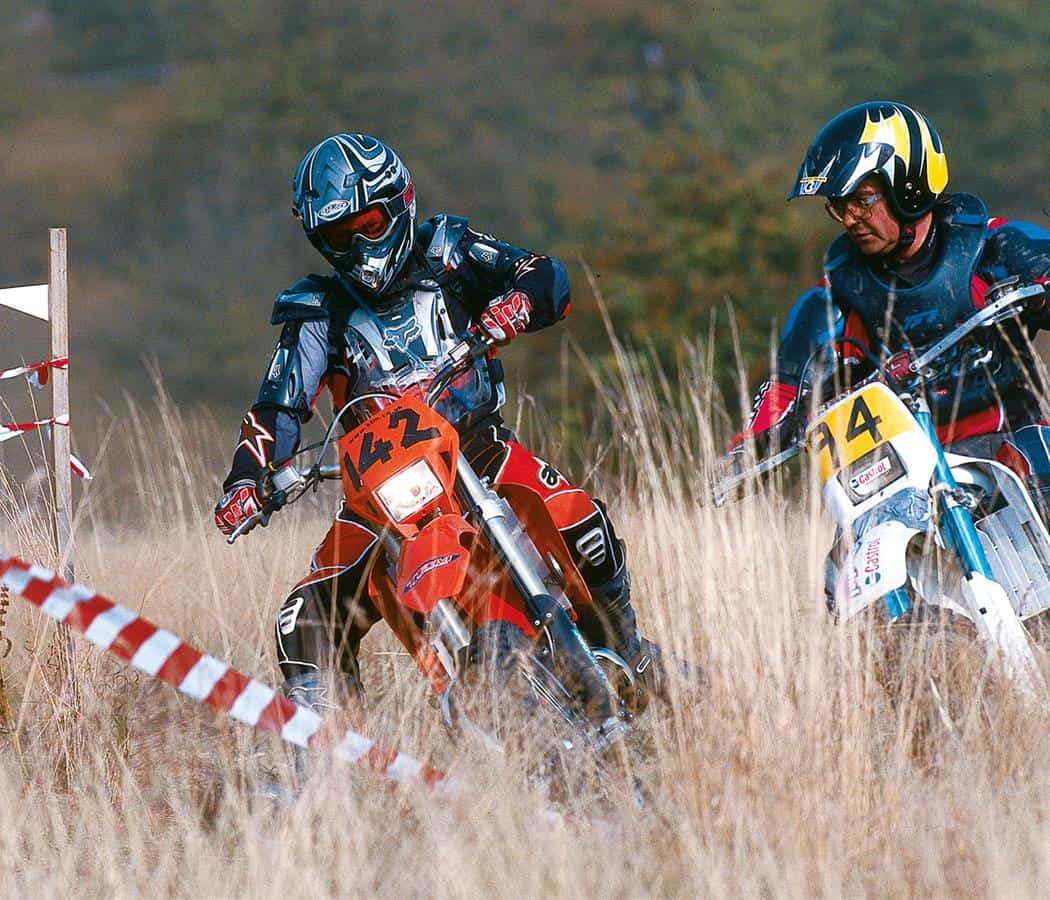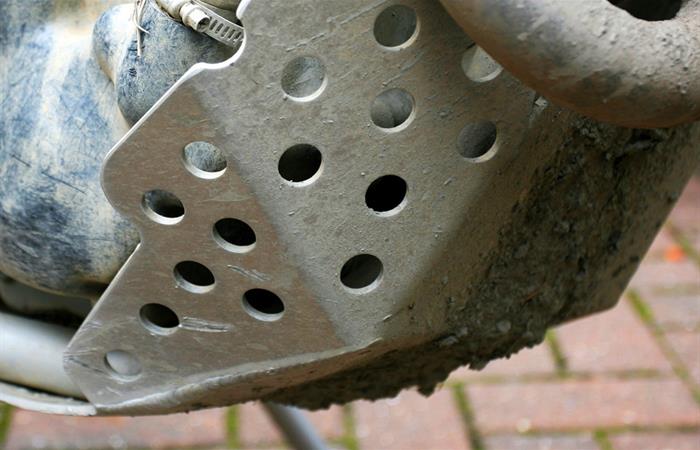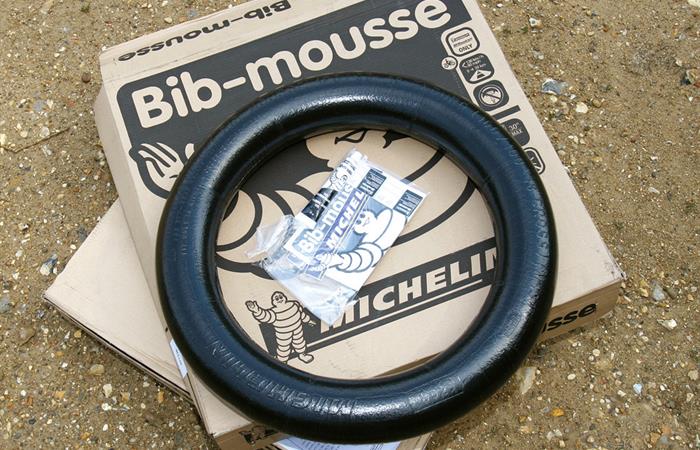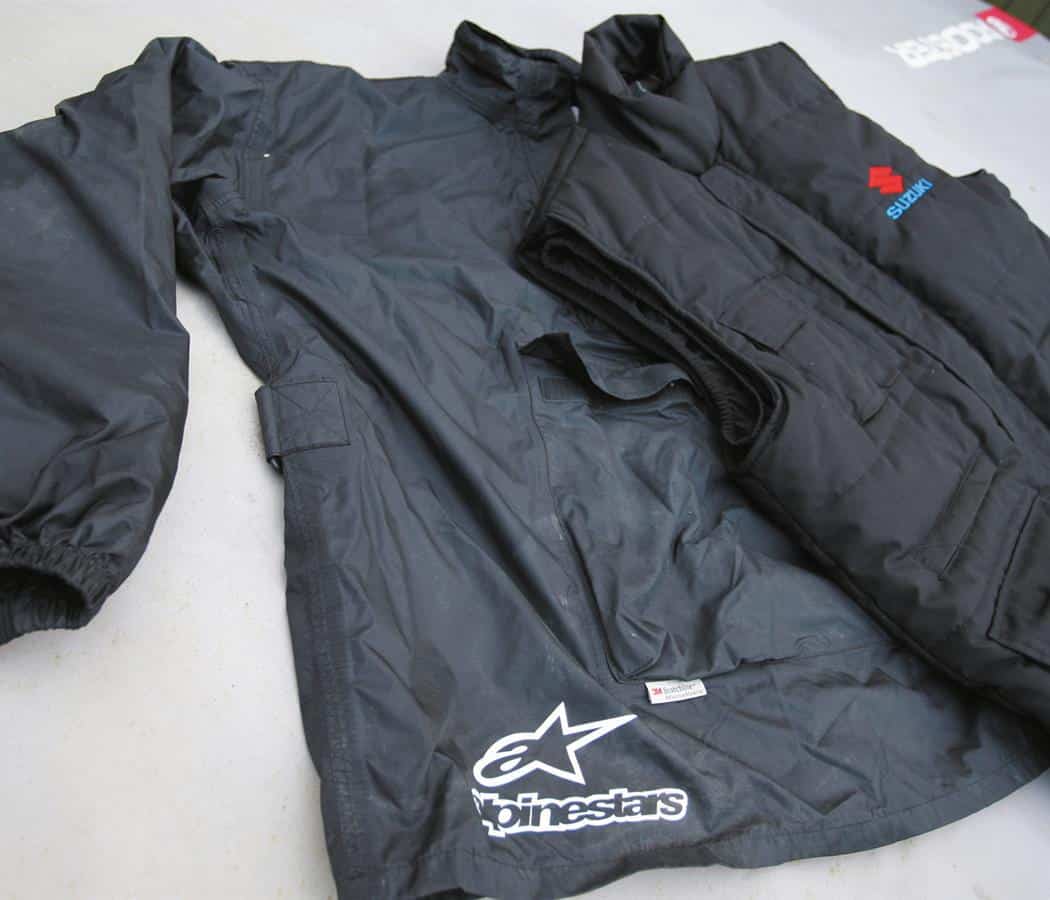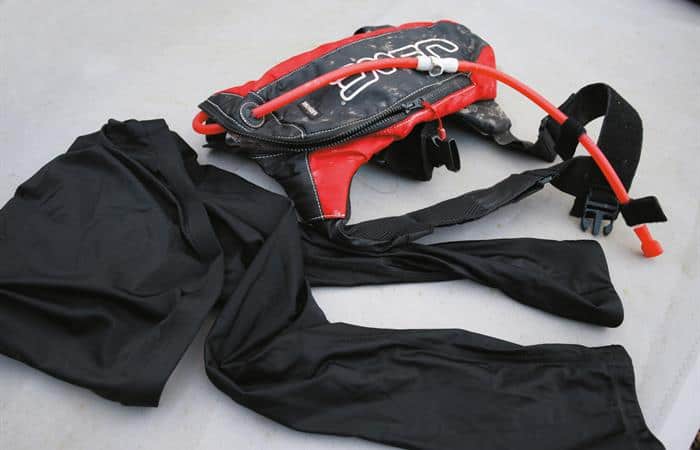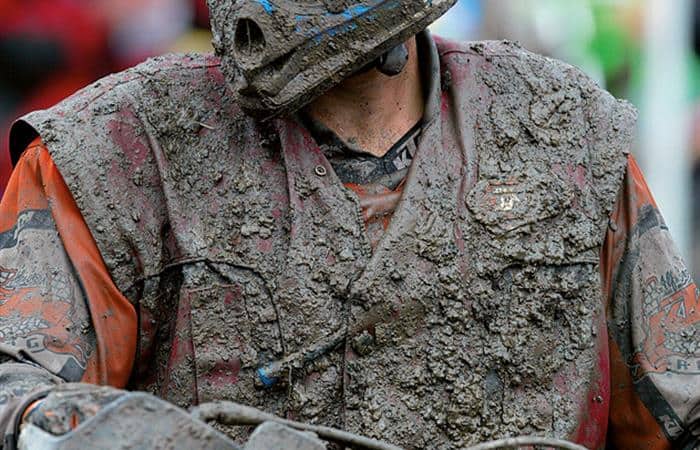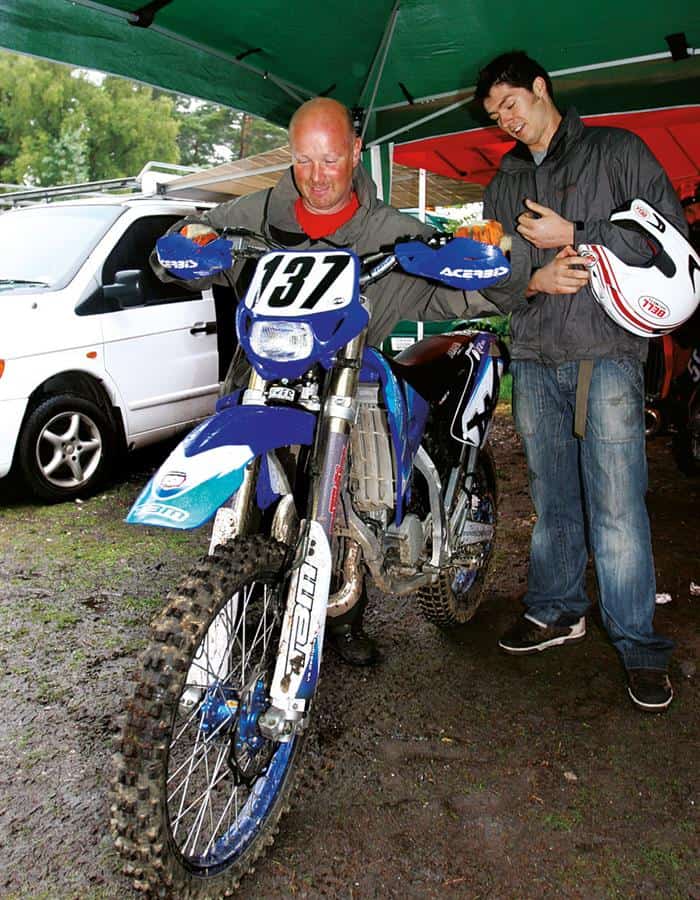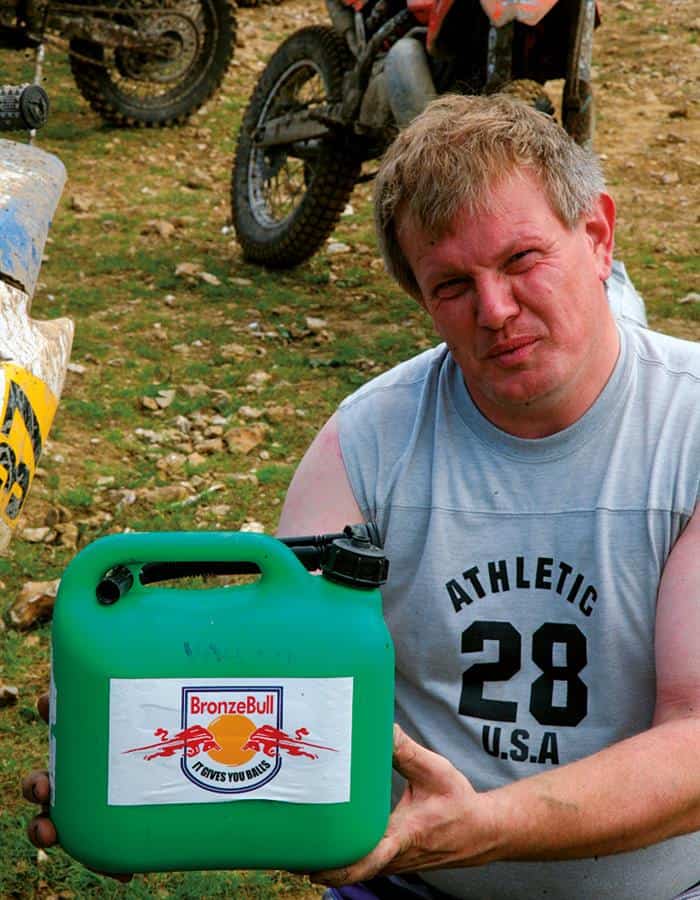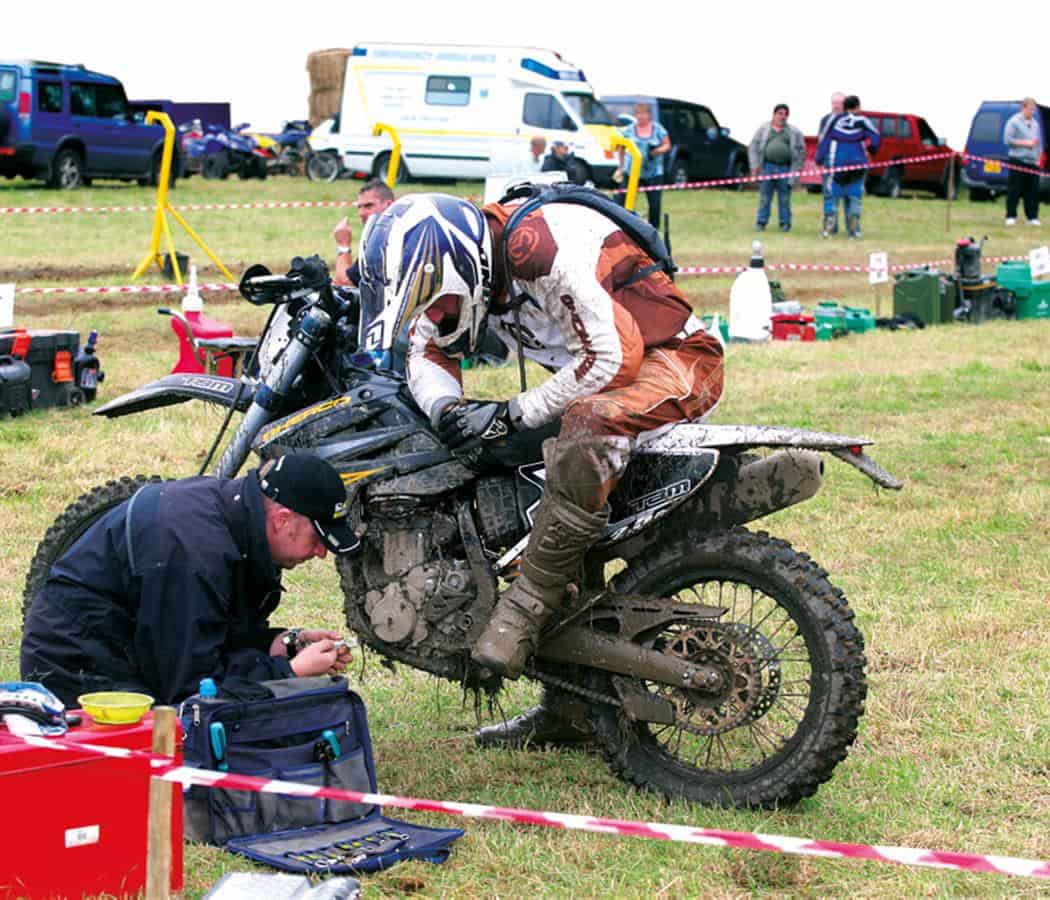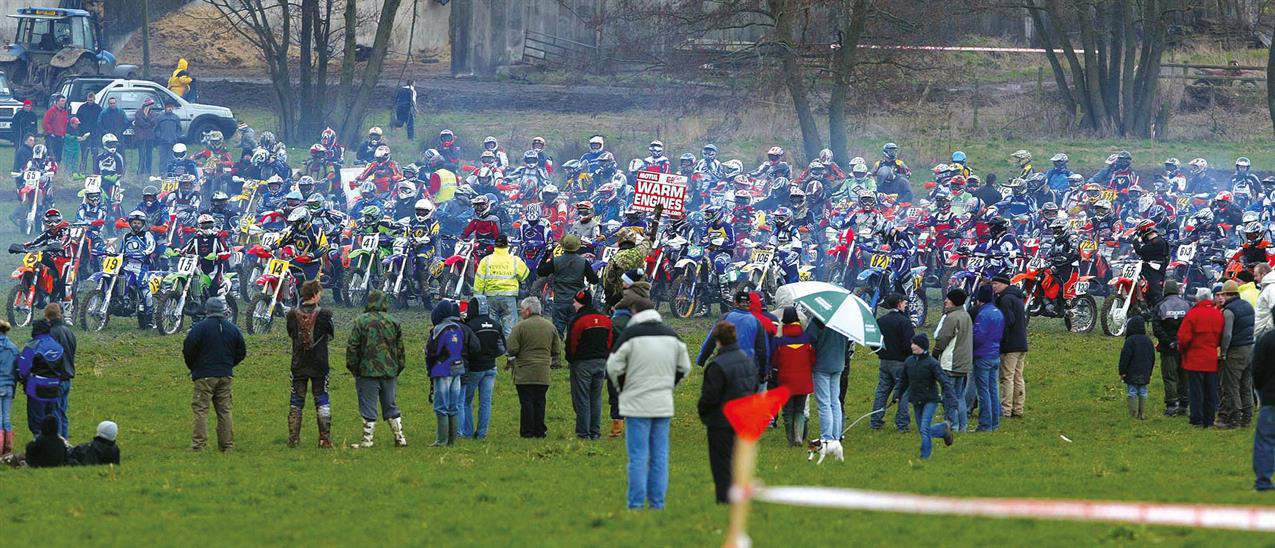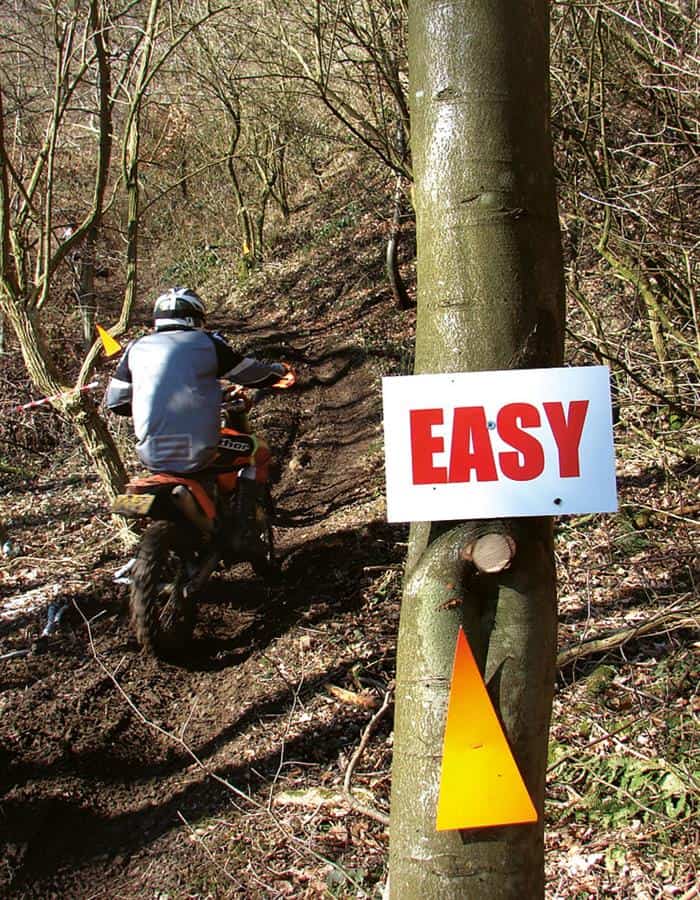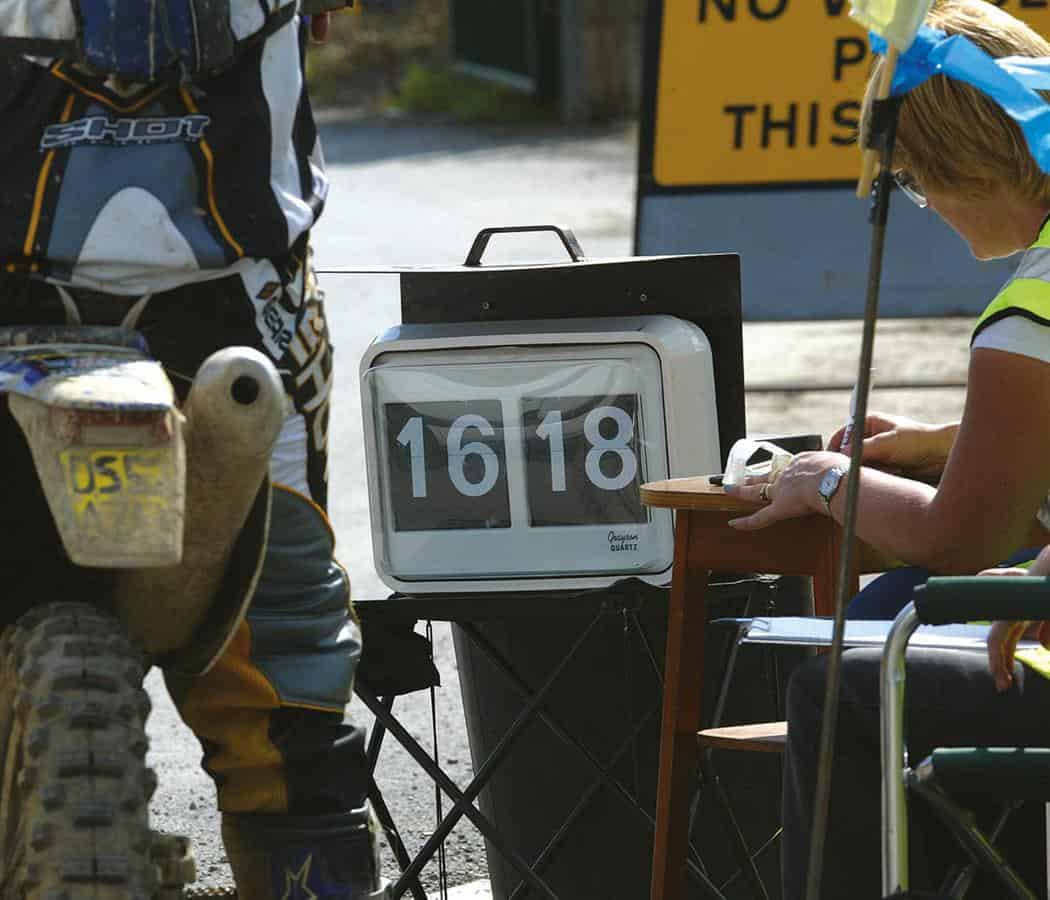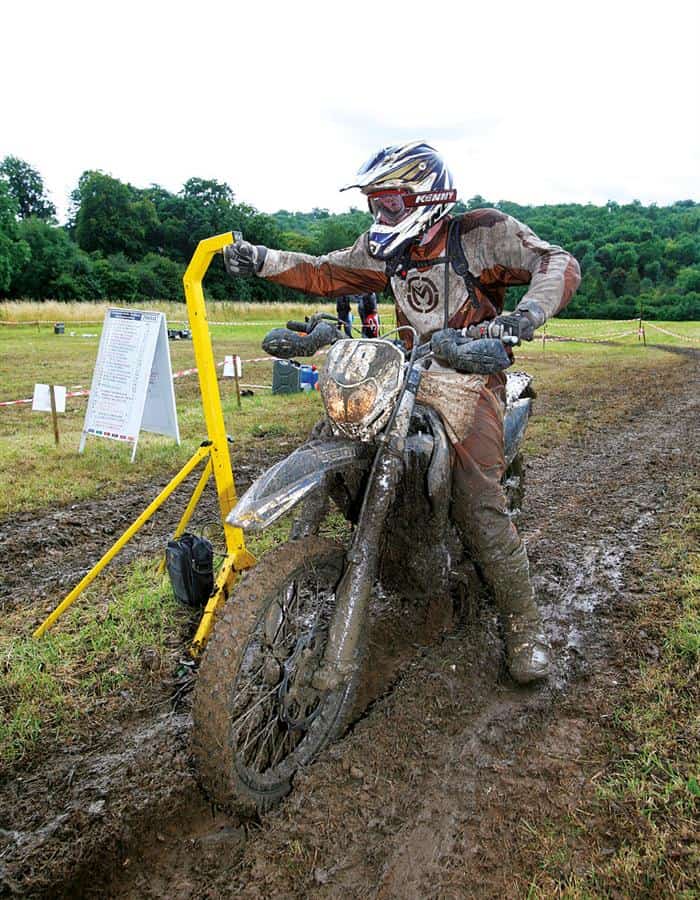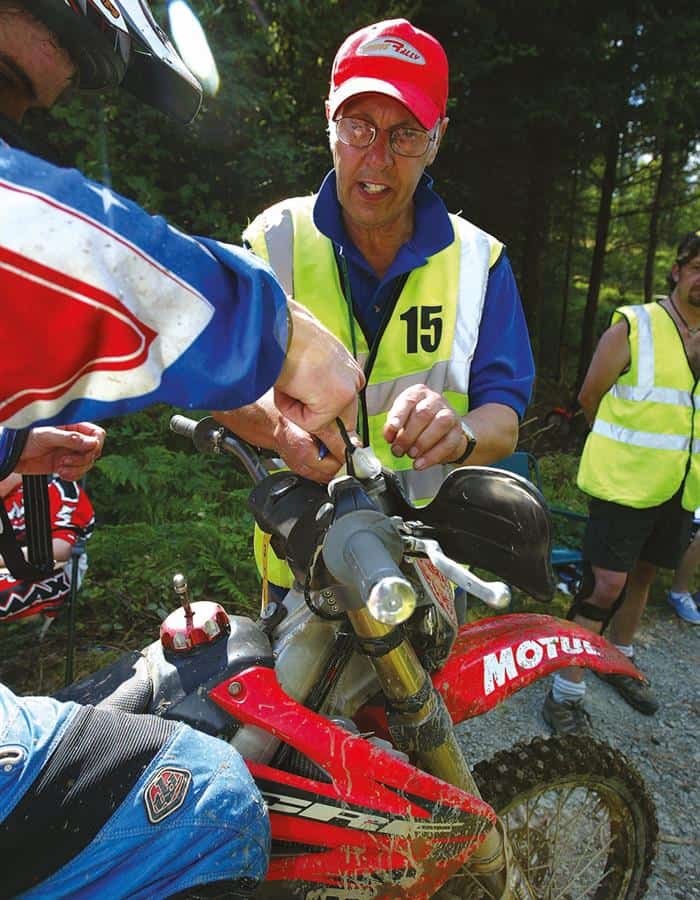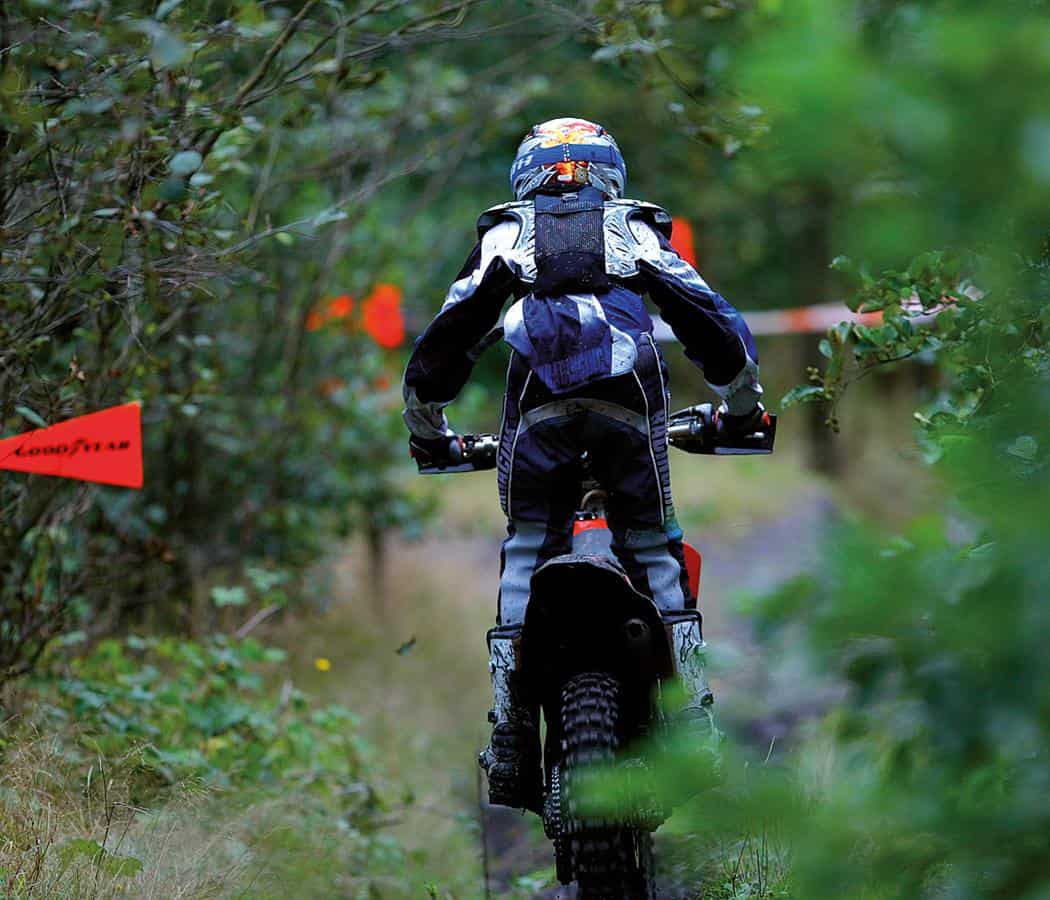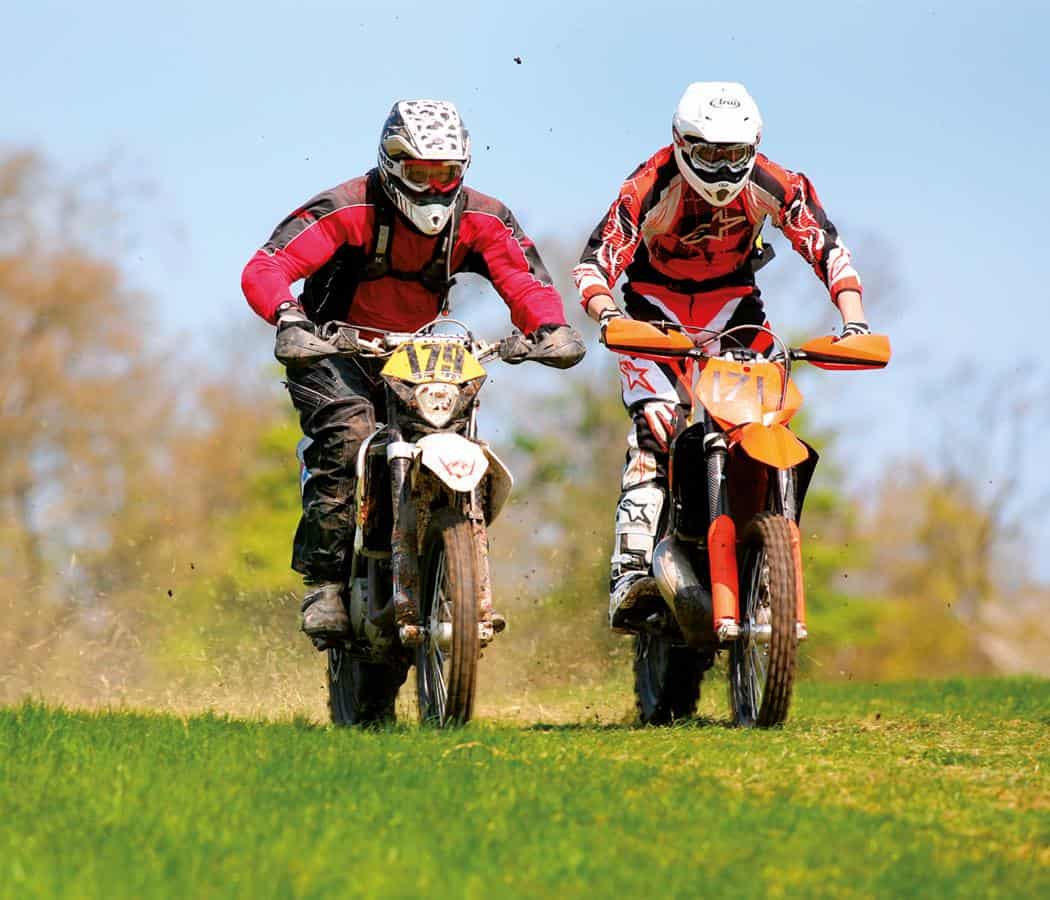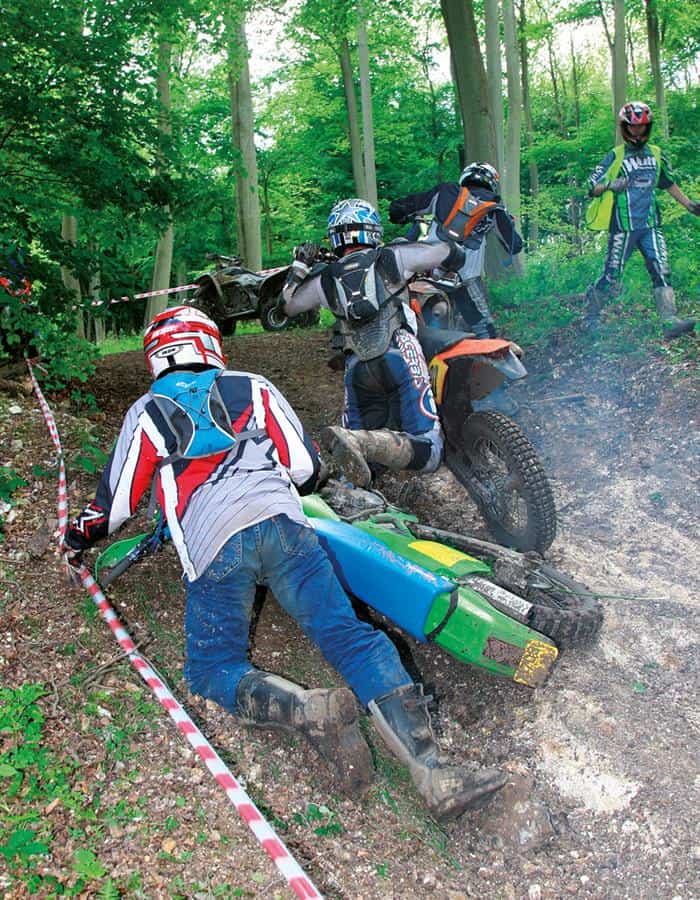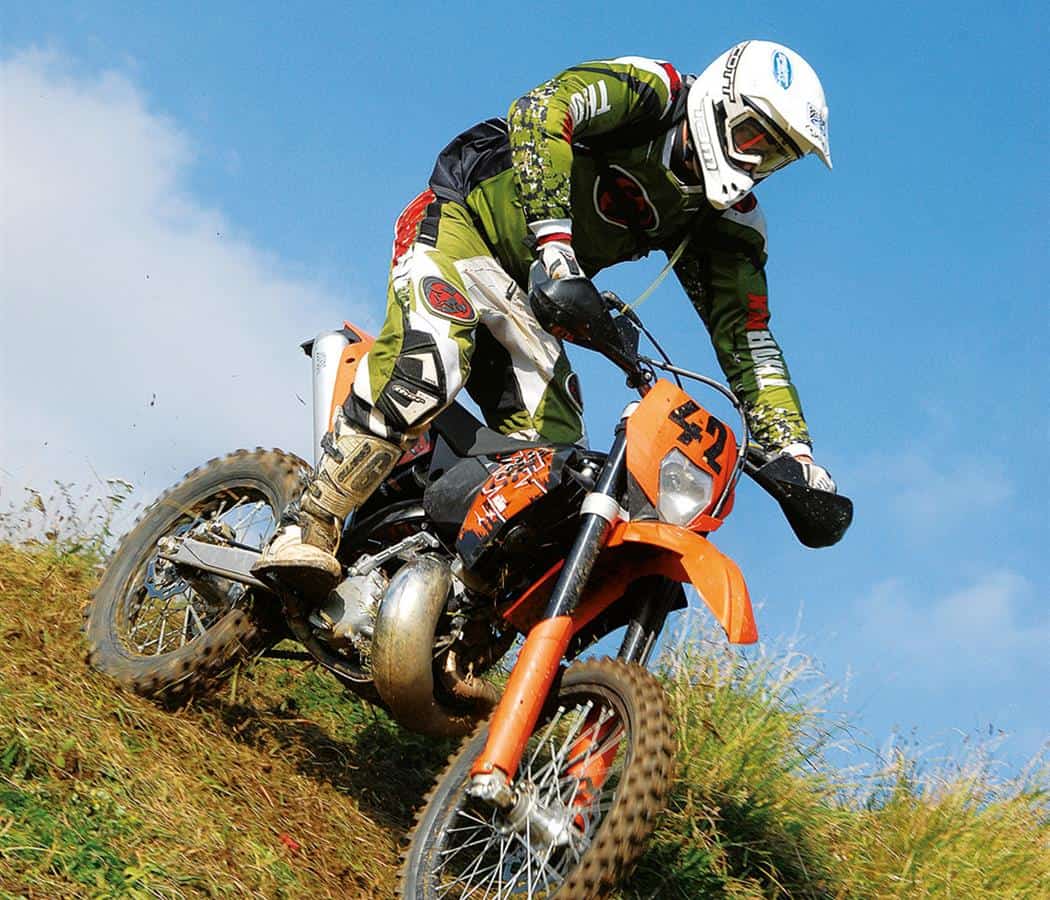READY TO RACE?
THE RUST BEGINNER’S GUIDE TO RACING
Accessible, fun, friendly and cheap: Hare and Hounds racing is a great way into enduro sport. Yet competing can still seem a daunting prospect to those who’ve never lined-up on a startline before. So here’s our guide to your first tentative steps in the muddy world of H&H racing…
Dirtbike racing is great fun. It gives you the high-speed adrenaline rush that you can’t get on UK trails, and surely every red-blooded male in the country has some streak. However, to someone who’s never raced before it can appear somewhat daunting. But it shouldn’t be… Club level enduro isn’t like its road racing equivalent, where grids are made up of riders who are CONSIDERABLY quicker than your average roadbiker. Sure, there’ll be some fast guys at any event but by-and-large club enduros are packed with average riders who are simply there to have a good days competition and race their mates. Yep, hobby level enduro is one of the most accessible motorsports going, and it certainly shouldn’t cost the Earth either. There are fixed costs – you need to pay your entry and you’re always gonna burn fuel – yet assuming you’ve got a bike and some kit (or can maybe borrow some..?), we reckon you could easily compete for under 100 quid! Still not sure? Well read on, and you might just find yourself on the startline…
We’ve based this guide on Hare and Hounds and cross-country (XC) racing as this is by far the most prevalent sub-sector of our sport right now. On any Sunday, up and down the country there are H&H races going on and in recent years we’ve seen a huge rise in the number of clubs organising them…
The Hare and Hounds Formula
The original H&H format has long since been buried in the roosted dirt of time, and we now refer to most events where you have a time limit (usually 3-4hrs) in which to ride a multi-mile off-road loop as many times as possible, as Hare and Hounds races. XC events are almost the exact same format – they just usually involve a mass start, as opposed to groups of riders being set-off at minute intervals.
Alternative Events
UK rally: Fantastic events for beginners, blending long non-competitive liaison sections with timed special stages. Often comprise of two or three laps of a 20-40 mile course, usually around forestry land. Fantastic friendly, social events, that feel like a natural progression from trail riding. Classes to suit all bikes/abilities…
Long Distance Trials (LDTs): Trail ride around a prescribed course (generally blending tarmac roads, trails and private land) pausing every so often to ride a simple ‘trials’ section feet-up. These can be anything from snotty bombholes and incredibly tight turns around trees to streambed rocksteps and stone-slab climbs, which test your balance and bike handling skills more than your speed. Small, light bikes with grunty ‘chuggable’ motors work best (Pampera, CRF230 etc) though some clubs do allow enduro machines to enter. If you’ve got a KTM you’ll want to wind the lockstops in..!
Timecard enduro: This is the traditional enduro and the format that the BEC and EWC use. You’re given a set time to ride a certain section of course (known as a ‘check’), or a number of laps. Arrive early at the checkpoint and you can sit and wait to clock-in at the prescribed time. Arrive late and you’re penalised, plus it’ll have a knock-on affect all of the subsequent timings for the rest of the event! On top of the checks, you also have to ride a timed special test (or a number of tests), which more often than not determines the winners. The courses are often quite tough, and working out the timings means it tests your mental as well as physical skills.
Fitness Levels
Whether you feel physically up to racing, only you can decide. You don’t need to be ‘triathlon’ fit, though if you get out of breath doing up the buckles on your boots then you may want to think twice. Naturally, it’s more strenuous and ‘high impact’ than trail riding, and there is the potential to clash with other riders, but on the whole it’s as tough as you make it, and you can adjust your pace to suit.
Budget Tip: Before you splash out any money on racing, go along to a local event and see if you like the look of it. This will also give you some idea of how things work, and allow you to speak to both riders and organisers.
Months/Weeks Ahead
Okay, you’ve decided to take the plunge, so you need to pick an event. Your riding buddies, fellow forum dwellers, or your local dirtbike shop are likely to know what’s suitable for your skill levels, alternatively contact a club and ask them. They’ll want you to come back for more, so they’re likely to tell you if it best suits expert riders or is achievable for a first timer. There are clubs which run beginners’ series or host events aimed at newcomers, and some who specialise in novice and intermediate level races.
Budget Tip: You definitely don’t need the latest tackle or a dedicated bike to go racing. Far from it. You probably wouldn’t want to enter a British Championship round on an MT500 or a Serow, but most local club races see a real mix of machines competing. As long as your dirtbike’s got enough poke to get you up a steepish hill, enough ground clearance to clamber over a fallen log and you’re not concerned about dropping it, then pretty much anything goes – from learner 50s to big trailies! Of course, there’s a caveat to this, and that is that whilst a H&H bike doesn’t need to be road legal certain clubs won’t allow converted MX bikes to enter.
Traditionally you’d send off for a set of regs and an entry form from the club, though nowadays they are usually downloadable from the web (try enduronews.com or individual club websites) and you can often pay online too. When it comes to filling in the entry you’re occasionally grouped by what machine you ride, but it’s usually done on ability. And there’s sometimes confusion about the class structure, as to many people ‘clubman’ sounds as if it should be the lowest class. It isn’t. ‘Sportsman’ is the class for beginners – those who are new to the sport. And that’s not ‘I’ve done five seasons of expert level motocross but never an enduro so I’m new to the sport’! Sportsman is aimed at novice riders..!
Alternatively, if you think that you’re fairly handy then enter a higher class. In H&H you’ll ride the exact same lap as everyone else, so the only thing that changes is where you’re shown in the results.
Budget Tip: Get your entry in nice and early. Clubs rely on rider numbers and if it looks like an event won’t be financially viable then they’ll pull the plug. But more than that, if you leave it to the last minute some clubs won’t accept that you’ve pre-entered and you’ll have to pay an increased entry fee. Entering on the day (if permitted) is usually at least a tenner more than doing so beforehand.
You’ll often need to join the organising club, and almost all events require you to have a race licence for the relevant governing body – the ACU, ORPA, AMCA etc. This is something else which you need to organise in plenty of time as (in the case of the ACU) you will have to join the club, send them the form to sign, and they then forward it to the governing body. Alternatively, you may be able to arrange a ‘day licence’ at the race, just don’t bank on it. Be aware that different clubs will be affiliated to different organisations, so if you subsequently go racing with another club you may need yet another licence. Third party insurance is covered by the entry fee, health/accident insurance is not.
Budget Tip: If you think that you’ll be competing in more than a handful of races in a year then it’s more cost-effective to get a year’s licence. A 12-month ACU enduro licence costs £43. If you’re uncertain then a ‘day licence’ (normally around £10-15 and arranged on the day) is the way to go.
Useful Contacts
ACU www.acu.org.uk 01788 566400
AMCA www.amca.uk.com 01543 466282
ORPA www.orpa.co.uk 01903 265738
If you’re anything like us you’ll then sit back and relax until the night before the race, at which point you’ll run around in a blind panic because your ‘unwashed-from-the-last-ride’ kit has spouted legs and walked out of its own accord and your bike is still partially disassembled from your last bout of spannering. So best do as we say, not as we do…
Prep your bike in plenty of time, so that if you need to replace something you’ll be able to get the parts well before raceday. Most, but not all, clubs will scrutineer your bike to check that it is safe – that the throttle snaps shut; pegs fold up; the brakes work; spokes aren’t loose or wheel bearings shot. That kinda thing. They’ll also check that your helmet meets the required regs (features an ACU Gold sticker and/or is E-marked inside) and is in reasonable nick, and that your exhaust is sufficiently quiet.
If your existing tyres are getting worn then you’ll ideally want a new pair and, to avoid punctures, be running mousses. You’ve paid to ride, not spend half your time mending a flat.
Budget Tip: If you can’t stretch to a set of mousses then liquid tyre sealant will help keep you puncture-free. And if new tyres are outside of your budget (even low cost brands such as Vee Rubber) then consider turning your existing ones if the knobbles still have a sharp leading edge.
What other bike prep do you need to do? That really depends on what bike you’re riding, the course and the weather. The main thing is that you want it to be in as good condition as possible, and get you to the end. So it’s really just a case of preventative maintenance such as going over all of the nuts and bolts, dropping the oil, cleaning the air filter, checking there’s plenty of life in the brake pads etc. That said, if you’ve not got handguards fitted then they’re a worthwhile purchase. Open-ended or flag-style, the choice is yours. You just want something that will deflect roosted stones and prevent you from clanging your fingers on trees. Oh, and fit a barpad too…
Once you’ve entered you will be given a race number (this information is usually posted online) and in the race regs it will say what colour background these should be displayed on. These can often be bought at the race, but if you get them sorted beforehand then they’ll probably be cheaper and you’ll know that your bike is ready to go…
Budget Tip: If you think you’ll be doing a lot of racing then buying stick-on numbers in bulk is cheaper than purchasing them individually. If you’re REALLY strapped for cash then duct tape – universally known as ‘numbers on a roll’ – can be used to fashion the digits! You’ll probably be using the same colour backgrounds all season, so keep them in place and try not to peel ‘em off with the jetwash. A big sheet of coloured ‘fablon’, bought from a craft store, will work out cheaper than buying smaller sections, too.
Does your bike feature a fenderbag full of tools? Have you got a spare tube strapped to the back? Whilst it is sometimes handy to have a few spanners on you when racing, at most H&H you’d generally limp back to the pits to fix most problems. So we’d suggest losing any extraneous weight.
Budget Tip: Good bike prep can save you money in the long run, preventing unforeseen expenditure. Similarly, if you’re racing in a rocky area then shelling out on a bashplate can save you a few quid on engine case repairs. If all else fails, you could fashion something out of some old metal or thick plastic, or perhaps just buy some ‘liquid metal’, pray to the god of big pointy rocks, and wing-it…
When it comes to riding gear you definitely want to be wearing MX-style boots, and most clubs insist on it. Then, aside from your helmet, the rest is entirely up to you. If you want to deck yourself out in overalls, a gimp suit, or that oh-so fetching jumper your gran knitted you for Christmas that’s your prerogative. Of course, most people wear enduro/MX kit…
But wear what you feel comfortable in – we’d normally go for a base layer, body armour and a race shirt on top. Having separate body armour, as opposed to a riding jacket with shoulder/back/elbow protectors fitted, allows you to wear lightweight layers and remain cool. Even if it’s cold, don’t be tempted to head off from the start in a big ‘n’ bulky winter jacket. You’ll overheat in seconds. Instead try a lightweight enduro jacket, a throw-over rain jacket, or maybe even a hoodie.
If you’ve got a dirtbike then it’s likely that you’ll have an off-road lid and goggles, but if you usually wear a visor’d dual sport lid then remove the visor and wear goggles instead. Aside from anything else, a scratched lens is cheaper to replace than a scuffed visor! Should you only have an open-faced lid then we’d recommend getting hold of a helmet with a chinbar – not only will it give greater crash protection, it’ll also prevent you from eating too much roost. And a good anti-fog coating or double-glazed lens for the goggles is an insurance policy against getting misted-up and having to stop or remove your goggles. If you’ve got them, then chuck in a spare pair too.
Knee braces, knee guards, neck brace, or neckwarmer – such extras are simply personal preference. We would, however, advise that you include a hydration pack, a spare pair of gloves and a set of earplugs in your kitbag. Maintaining hydration is crucial, and a hydration pack means that you don’t have to stop to take on fluids.
Budget Tip: If you can’t stretch to a quality hydration pack then cheap ‘n’ cheerful versions are often available from stores such as Lidl or Aldi.
You’ll really appreciate the spare gloves if conditions are heavy or if it’s so hot that they get sodden with sweat. And the earplugs? Well you’d be surprised how draining the constant noise from bikes can be, and wearing earplugs allows you to concentrate on your riding. You should still be able to hear bikes behind you, so don’t worry on that score.
Some clubs insist that you wear dogtags, detailing your name, an emergency contact number and any pertinent medical information. It’s not a bad precaution…
Packing List
So, your bike’s prepped and your kitbag’s packed. What else do you need? Fuel. How much you’ll need depends on your bike, the event, and the course. For an average event in dry conditions a full 20-litre jerry should be more than enough to see you through the day (including filling up before the start). Ideally, we’d recommend splitting it into smaller cans as they’re easier to wield in the pits, and don’t forget your funnel or a pouring spout… we need someone to borrow one from ‘cos we’re always forgetting ours!
Take a selection of tools. You’re unlikely to be stripping down your engine to its constituent parts so you won’t need a fully loaded Snap-On roll-cab, just the basics. Chuck in a footpump, some tyre levers and a tyre gauge if your bike’s on inner tubes, and set the pressures on the day when you know what the conditions are like. If you’ve got any spares that might come in handy then pack them too – levers, tubes, split link for the chain, and the like. You don’t want to ruin your day for the sake of a broken brake lever! Also pack some engine oil, brake cleaner, coolant, cable ties and duct tape etc. Having a paddock stand is handy, but by no means compulsory – someone will doubtless lend you one if needs be.
Throw in a few rags. You’ll never know when they’ll come in handy. If it’s raining or the course is muddy then having a goggle-wiping rag is a godsend. We usually tie it to the bars and then tuck it down behind the headlight so that it stays as clean as possible, and that way it’s easy to reach when you need to clear your vision.
Often you’ll see in the regs that a fire extinguisher is required for the refuelling area and also an ‘environmental mat’ to catch any oil, fuel or coolant spilt in the pits. Most motoring stores will sell you a small extinguisher for under a tenner – it’s a handy thing to have outside of racing anyway – and an old piece of carpet can be used top soak-up those errant fluids. Whether the club actually demand either on the day is another matter…
We’d definitely advise taking someone along with you, even if it’s a mate who’s racing too. It’s great to have someone there who can give you some moral support, help you refuel, load the van afterwards when you’re knackered, and feign interest in your post-race over-exaggerations..!
Budget Tip: Splitting costs and pooling resources with friends is a great way to save money, and that goes for everything from sharing a van travelling to events to buying consumables. For instance, a drum of oil works out considerably cheaper than buying it in small quantities and can be split between your mates…
The day before the race you’d ideally drink plenty of fluids so that you’re well hydrated, eat a healthy high-carb evening meal such as pasta and perhaps lay-off the sauce (that’s beer not Bolognese!). You’ll feel much better for it when you’re riding…
Budget Tip: Stock-up on food and drink for the race beforehand. It’ll be cheaper and you’ll be able to choose from a wide range of stuff that will boost your energy levels and actually do you some good. Pack a Thermos – you’ll have a good supply of hot drink if it’s cold, and you can fill it with ice if it’s going to be scorching.
The Big Day
Most clubs will include directions to the venue in the regs or post them online. Traditionally there’ll be coloured arrows taped to lampposts or staked into roadside verges as you near the race too. Take note of the times that signing-on and scrutineering close, as even if you’re going to be one of the last riders to start you’ll need to get there in plenty of time. If you get lost, as a last resort follow the first beaten-up Vito with 18in rims that you see (though not one with 22in rims – they’ll be heading to a motocross!).
Once you’re arrived in the paddock, the first thing to do is sign-on with the organisers. They may also give you a lap-scoring transponder (often a wristband that you swipe against a reader at the end of each lap, which you’ll want to wear on your right wrist so that you can whip the clutch in with your left hand) or explain to you how they count your laps. If you don’t know, ask.
We’d then suggest getting your bike scrutineered before you get changed into your riding gear. Wheel it over to the scrutineers – riding in the paddock is often a no-no – and take along your crash helmet too. They’ll give your bike the once-over and, assuming it passes, you can then put it in the parc ferme area.
Parc ferme can be a simple holding area to park-up in, or it can be laid out so that you leave your bike alongside others in your class or with those who’ll be starting on the same minute. A piece of wood or a squashed Coke can comes in handy as a sidestand puck if the ground’s too soft for your sidestand.
Nerves kicking in? Stomach doing a ‘superman backflip?’ If you’re going to be visiting the portaloos might we suggest now’s a good time to do so. Once 200 other riders have sampled the dubious delights of Del’s Burger Wagon it, much like Del’s breakfast roll, will be a less-than-pleasant experience..! Speaking of sustenance, chomp down some of those bananas and cereal bars you bought beforehand and, again, keep your fluid levels topped up…
Take your fuel to the pits, along with anything else you think you might need mid-race such as some tools, food and spare gloves. Try to make your stuff stand out amongst the sea of green jerry cans and note where you’ve left it in relation to the pit entrance – it’ll save you time later.
If there’s time walk a little of the course. We’re not saying that you need to trudge around the ENTIRE lap, but you should at least look to see which way the first turn goes and if there’s any nasty surprises lurking just around it.
There’ll usually be a riders’ briefing 15-20 minutes before the start. The organisers will normally signal this by some means (shouting, sounding an airhorn etc) but look out for riders congregating together or wandering towards the start as this is a good indication of an impending meeting. Club regulars might treat the briefings like the safety announcement on an aeroplane – if you’ve heard it once you don’t pay attention ever again – however we’d suggest you listen-up, as they’ll let you know the format for the day, highlight any tricky bits out on the course, and generally arm you with the information you need. If you want to know something don’t be afraid to ask, or have a chat with some of the other riders.
One key piece of information you need to know if you want a good result is how the organisers ‘score’ the laps. For example, you may be awarded a number of points per lap, and then have points deducted if you finish your final lap outside of the time limit. How many points per lap you’re given, and how many they deduct per minute of lateness, is crucial. Because if you arrive at lap scoring with 15 minutes to go, and it’s a 25 minute lap, you need to know if it’s worth trying to squeeze in that extra circuit. Alternatively, the club may simply count the number of laps you complete, and as long as you start your final lap within the three hours then that counts towards your total. The results are then based upon who rode the most laps in the shortest time.
The Final Countdown
There’s not long to go now, so keep an eye on the time – check that the course clock by the startline matches your own watch. We’ve been that person still getting changed as their start-time came and went, and you look bloody daft hopping through the paddock with only one leg in your race pants and your shirt on backwards. You look sillier still heading BACK to your van as you realise you’ve forgotten your goggles too..!
Maybe think about performing a few stretches or a bit of a warm-up. Get some blood pumping and loosen up those stiff limbs. Then do similar for your bike…
Most clubs will let you warm your engine before the off, though some don’t (mainly due to noise issues). If you’re starting with a cold engine then resist the temptation to blat away at full tilt and take it easy until your bike’s running sweetly and you’ve turned the choke off.
Assuming you’re not amongst the first away, watch the start procedure for those ahead of you. Ordinarily it’s a dead-engine start and you can go as soon as your start time shows on the course clock or an official waves a starter flag. Whether it’s a handful of riders starting every minute or a wave of entrants racing for the first corner depends on the club…
First Lap
Now you’re racing! Just don’t let the red mist descend and ride a previously unseen lap like a football manager trying to escape the taxman. Allow yourself to warm up, look as far ahead as possible and try to read the terrain. As a general rule of thumb, the course is at it’s trickiest on the first lap as the ground hasn’t cut up, corners haven’t developed berms, and alternative lines haven’t developed. Assuming the weather plays ball, you’ll have an easier time of it later in the race.
Stand-up wherever possible. Resist the temptation to sit down and roost sideways out of corners MX stylee – it’s a waste of energy. There’s hours to go, so think about keeping things smooth. And breathe…
Some sections of the course will be marked-out with tape, others will simply have fluorescent arrows pointing in the direction of travel. Don’t blindly follow the rider in front! On UK rallies we’ve watched (and laughed at) people disappearing along fireroads never to be seen again, completely oblivious to the fact that they’ve just blazed past a turn. And this is especially easy to do at H&H events run on land that’s seen regular race use, as there’ll be lots of old tracks on the ground.
If you miss a turn then backtrack slowly, sticking to one side and giving yourself maximum visibility. Be aware of other riders making the same mistake and coming towards you full bore!
The accepted marking for a hazard is with a pair of crossed arrows, and these could signify anything from a bombhole to a log crossing. Sometimes low branches will be marked, either with arrows or a ribbon of tape, others you’ll have to look out for yourself. One army-organised H&H we entered featured young recruits on every corner pointing the way, and every tree stump and low branch on the track had been highlighted with fluorescent paint. Don’t expect this level of marking at every event..!
Bottlenecks often appear at the trickier sections of the lap, and whilst you want to have the clearest run possible at the obstacle, bear in mind that there’s likely to be more riders along soon who’ll just add to the melee. Don’t sit and wait any longer than strictly necessary – if there’s a queue have a brief gander at how others tackle the problem, especially if it’s a bog or a mudhole. Has someone found a good line or is there a section where everyone’s getting stuck? You really don’t want soaked gloves or grips slathered in mud. Course-cutting is frowned upon, but you’re unlikely to run into trouble if you simply pick a new line around the edge of a blockage. And, as is often the case, maintaining momentum and attacking an obstacle with commitment will often serve you better than assessing and analysing.
Many clubs incorporate ‘hard’ sections into the lap to spice things up a bit and give the better riders more of a challenge, often adding an easier yet longer option for those who don’t fancy trying the tougher route. The severity of these varies from club-to-club, and mention of them will often crop up in the riders’ briefing so you should have a rough idea of what to expect. Taking the hard route can prove a great way to get past a slower rider, or save yourself some time, as long as you get through ‘clean’. Once you’ve picked a route then you’re committed to it – riding against the course is a no-no.
Blue marker tape means walking speed and is most often used around the lap scoring area or when the course crosses a public right of way. Britain will bag every Olympic track medal this year if our athletes can travel as fast on-foot as some riders do through blue-tape areas, though you risk exclusion if you’re caught taking the mick. A gentle pootle is the way to go…
When you come around to the lap scoring area take note of where the course clock has been placed, as it’s often moved slightly from when you started. Early on you won’t need to pay too much attention to your lap times, it’s at the end that they’ll be crucial.
How the transponder registers your lap varies from system to system. Those where you have to swipe an ‘armband’ will generally ‘beep’ and/or display a green light when you wave the transponder against the trackside reader. Ensure that it’s logged your lap, as it’s all too easy to hear the beep from another reader and think that it was yours. If the transponder is fastened to the bike, then you may see your race number appear on a screen or, again, a light appear.
With any luck you won’t be suffering from the dreaded armpump and you’ll be able to smile smugly when your mates talk of being barely able to hold onto the bars. Sadly, for many of us the early stages of a race are when the arms fill with lactic acid and we wonder how the hell we’re going to make it to the end of the lap, let alone the end of the race. The only shred of comfort is knowing that armpump does subside if you can bear with it. Long term, there are various ways to lessen, and even eradicate, it. Correct bike set-up (especially having your bars and levers set so that the pull of the levers follows the natural bending of your fingers), warming-up your arms, regular riding, and ensuring your gloves/armour aren’t too tight all help but each case is different. We know ultra-fit championship class racers who still suffer from it…
Passing Places
One aspect of racing that can put riders off is, well, the other riders! Or more specifically, the fear of being nerfed into a tree by some lunatic who simply must get past so that he can beat his mate into 33rd place. Well, fortunately, on the whole that isn’t the case with H&H (this isn’t motocross, you know!) and although there’s always one or two nutcases most riders will give a novice a wide berth.
It’s often said that you should never worry about what’s behind you – leave it up to the guy following to get past – and that a good rider will find a way through. It’s also said that the people who maintain this are eejits! Of course, in many ways it IS down to the guy behind to get round you and on a wide enough course a good rider WILL be able to comfortably overtake. It’s on singletrack – especially in woodland – or when the rider is only a little bit faster than you that things get complicated. Having a bike sitting behind you can be incredibly off-putting, enough to pressure you into a mistake. Don’t stop, suddenly swerve out of the way, or ride into the undergrowth as you may end up simply collecting the other rider or clanging into an unseen obstacle. Instead pull to one side when it’s safe to do so, slowing-up a fraction and perhaps signalling with your boot for them to pass on that side. So often simply moving a foot or two to one side or taking a wider approach into a corner can allow someone past, whereas resolutely sticking to your line could see someone attempt a dicey overtake. Besides, you’ll improve your lap times if you try to stick with a faster rider!
Whatever your speed, ‘race awareness’ is crucial. If you have to take a breather or your bike breaks-down on the course, think about where you park-up. And be aware of the potential differences in speed – to one rider a straight may be a fine place to have a rest and meander along slowly, to another it may be a good opportunity to make up some time and ride flat-stick…
Take a glug from your hydration pack whenever possible, little and often is the best way to drink rather than gulping down gallons in one go…
Mid-Race
By mid-race you’ll know exactly where the course is going, good lines will have developed, and you’ll have discovered exactly which sections give you trouble and where you’re really enjoying it. Hopefully the entry will have strung out a bit too, and you won’t be following a freight train of riders along a singletrack trail.
With numerous racers on the same piece of land, an enduro course features characteristics you’re unlikely to find on the trail. Branches hanging over puddles, or on the exit of a watersplash, covered in gloop are a prime example of this. If you were on the lanes you might not give a second thought to the quick swish of a leafy branch brushing across your face. But when 150 other riders have all been through that puddle countless times those leafs will be coated in muddy water, which will turn your once-pristine lens gritty and opaque, and scratch it when you wipe it clean.
Removing your goggles should really be a last resort if conditions are so bad that you really can’t see through them. The likelihood of getting roosted or a branch in the eye is much greater than on the trail…
Braking and acceleration bumps can start to appear into, and out of turns, and the course can change lap-on-lap with ruts and holes digging out, roots emerging from the dirt and rocks and logs getting kicked onto the course. With this in mind, and the fact that sometimes the organisers will cut-out problem sections, don’t take anything for granted.
Man Down
If you spot a fallen rider then, at the very least, ask them if they’re okay, and if they’re stuck under their bike then help them out. You’d only wish four-stroke exhaust burns on your worst enemy, or maybe select politicians..! Should someone be seriously injured then flag down another rider, or a travelling marshal, and summon help – noting the location on the course. If you’re genuinely helping out an injured rider the organisers should amend your result to reflect the time you lost if you explain to them what happened. Mind you, they probably won’t if you’ve just been helping someone extract their bike from six-foot up a tree…
Assuming your bike has the standard-sized enduro tank fitted, you’ll probably want to be thinking about refuelling around mid-distance. This is where a clear tank pays dividends, as you know exactly how much you’ve got left to play with. Unless you’re really hanging, resist the urge to spend too long in the pits (or pulling in purely to have a rest) as it’s easy to waste a lot of time doing nothing. You’re far better off dropping your pace and staying out on track.
Having sloshed some petrol into the tank, it’s well worth giving the bike a quick look-over to ensure that everything’s running smoothly. If the course is muddy, or there’s a lot of debris or grass being thrown up, then check that the rads are clear. And if it’s really dusty take a peak at your air filter to ensure that it isn’t getting clogged.
Some clubs split the race into two halves, with a ‘lunchbreak’ inbetween. They’ll have announced this in the regs or at the start and you’ll want to have worked out what time you need to pull-in (depending on how long the race is…).
Once you’ve parked up, usually in the refuelling area, we’d recommend taking on some more fluids, salt (good for preventing cramp) and some more slow-release carbs. You don’t really want anything that’ll sit heavy on your stomach or give you an immediate ‘buzz’ – you’ll only end up feeling more drained. Give your bike a once over (check the air filter, the chain tension etc), fill ‘er up with fuel, and top-up your hydration pack. Find out what time you restart, then kick back and relax…
Occasionally clubs reverse the lap in the second half of the race, and you’ll soon know if you’ve got this wrong..! By and large, you’ll be riding in the same direction as before, so you’ll know roughly what to expect.
Towards the End
As the clock winds down and the end gets nearer, fatigue will doubtless kick-in. Keep drinking from your hydration pack, and if you’re feeling drained then neck some Jelly Babies or something to give you a bit of a kick to get you to the end. Try to keep your concentration level up, as it’s now that you’ll start making unforced errors, and will have less energy to react to them too. You’ll almost certainly see some riders sitting waiting for the end, as they don’t want to finish too early and not be counted as a finisher or be forced to start another lap. If you’re still feeling fighting-fit then the final lap can be the most enjoyable, as the course is at usually its quietest.
The Chequered Flag
Crossing the finish line will likely elicit a mix of elation and relief, a buzz that you’ll likely experience for many races to come, especially if conditions are tough.
If you’ve got someone helping you, despatch them to collect your fuel cans and tools from the pits. Feign an injury if they protest. Meanwhile, hand back your transponder on your way past the organisers’ tent – forgetting to do so may see you excluded from the results or possibly forfeit any deposit paid.
If you’ve been racing your mates then the post-race debrief comes next, discussing the tricky climbs and awkward root-fest of a forest track, with the odd jibe about roosting past them thrown in for good measure.
Then all that’s left to do is to head for home and a well-earned soak in the tub, or down the pub for an equally deserved pint. The results will be posted (usually on the club’s website) in a few days, and you can start planning your next race…

